 ACCREDITED RESEARCH STUDIES ON AGAPORNIS
ACCREDITED RESEARCH STUDIES ON AGAPORNIS
If you would like to make a donation, use the Paypal link below. If you would like to send a check or Money Order please mail to:
ABE
P O Box 86013
Plano, Texas 75086
On behalf of Agapornis Breeders & Exhibitors we would like to thank those who have donated graciously to any research/studies regarding the agapornis. Your gesture is appreciated as research is an important part of the survival of certain agapornis species in the wild. THANK YOU!
SPANISH – Queremos dar las gracias a esas personas quienes donaron a los estudios/investigaciones científicas de agapornis. Este gesto es apreciado ya que las investigaciones científicas con ciertas especie de agapornis son muy importante para que puedan sobrevivir en la naturaleza. ¡GRACIAS!
Any other donations for shows, awards, etc., please let us know or use the PayPal button above.
** COPYRIGHT AGAPORNIS BREEDERS & EXHIBITORS
————————————————————————————————————————————
We are trying to help with the Agapornis Nyasa Research Project through the University of Kwa-Zulu Natal in South Africa. Tiwonge Mzumara is conducting this research in Liwonde National Park in Malawi and we would like to help her continue by raising some funds. If you would like to donate even if it’s a very small amount please let us know. Visit our web page for more information regarding the Nyasa Research www.ABE-international.com
Please donate for this research, these birds are being poisoned in their native land and her work is important to the survival of the species.
Nosotros estamos tratando de ayudar con el proyecto de investigación científica de Agapornis Nyasa con the Universidad de Kwa-Zulu Natal en Sudáfrica. Tiwonge Mzumara está llevando a cabo esta investigación en Liwonde National Park in Malawi y nos gustaría ayudarla a continuar colectando algunos fondos. Si ustedes pueden ayudar aunque sea una cantidad pequeña, por favor háganoslo saber. Visite nuestra página web para más información sobre la investigación/estudios científicos con los Nyasawww.ABE-international.com
Estos estudios son importantes, estas aves están siendo envenenadas en su tierra natal y el trabajo que esta haciendo Tiwonge Mzumara es importante para la supervivencia de la especie.
Stiamos cercando di aiutare con il progetto di ricerca scientifica Agapornis Nyasa con l’Università di Kwa-Zulu Natal in Sudafrica. Tiwonge Mzumara sta conducendo questa indagine nel Liwonde National Park in Malawi e che noi per aiutarli a continuare a raccogliere alcuni fondi. Se si può aiutare anche una piccola quantità, fatecelo sapere. Visita il nostro sito per ulteriori informazioni sulla ricerca/studi scientifici con la www.ABE-international.comNyasa, questi studi sono importanti, questi uccelli sono stati avvelenati nella sua patria e lavoro facendo Tiwonge Mzumara sono importante per la sopravvivenza della specie.
We hebben als doel te helpen bij het onderzoeksproject van de Agapornis Nyasa
met de Universiteit van Kwa-Zulu Natal in Zuid-Afrika. Tiwonge Mzumara is de verantwoordelijke onderzoeker in Liwonde National Park in Malawi en we zouden haar willen haar helpen met een geldelijke donatie. Donaties zijn altijd welkom hoe groot of hoe klein die ook mogen zijn. Geeft ons gewoon een seintje. Bezoek onze webpagina voor meer informatie over het Agapornis Nyasa onderzoek, www. ABE-international.com. Doe een inspanning door middel van een donatie, deze vogels worden in hun geboorteland vergiftigd en haar werk is belangrijk voor het voortbestaan van de soort.
FRENCH
Salut,
nous essayons d’aider avec le projet de recherche scientifique Agapornis Nyasa avec l’Université du Kwa-Zulu Natal en Afrique du Sud. Tiwonge Mzumara mène cette enquête dans le Parc National Liwonde au Malawi et souhaitez que nous les aidons à poursuivre la collecte des fonds. Si vous pouvez aider même une petite quantité, s’il vous plaît laissez-nous savoir. Visitez notre site Web pour plus d’informations sur les recherches/études scientifiques avec la www.ABE-international.com Nyasa ces études sont importantes, ces oiseaux est été empoisonné dans son pays natal et travaille faire Tiwonge Mzumara sont importants pour la survie de l’espèce.
RESEARCH INFORMATION (SEE BELOW):
‘Tiwonge Mzumara is an ornithologist based in Malawi and working for the
Museum of Malawi. She completed her MSc in Conservation Biology at the
University of Cape town in South Africa in 2009. She has currently just
registered for a PhD in Ecology with the University of Kwazulu Natal. She
has been involved in various research on the conservation of birds in Malawi
and is a voluntary research officer for the Wildlife and Environmental
Society of Malawi. She is also the country coordinator for the African bird
Club in Malawi. Her research on the Lilians lovebird in Malawi began
after a simple observation of their poisoning in 2006 during an annual game
count. In 2010 a pilot study was done which discovered more hunting in
agricultural fields. Her PhD is title the Ecology and Conservation Biology
of the Lilians lovebird in Malawi. She will investigate various ecological
and social issues to better understand how the lovebird can be conserved in
their current habitat.”
RESEARCH INFORMATION – UPDATES IN SEQUENCE OF EVENTS (SEE BELOW)
INFORMACION DE INVESTIGACIONES – SE ENCUENTRAN EN ORDEN DE FECHAS
Lilians Lovebird Brief Report
Funding received from the Good Gifts catalogue and BirdLife international enabled the study to use certain equipment to monitor lovebird movement in Liwonde National Park. Towards the end of October Wildlife Society Member, Mr Phil Pile (an expert in radio equipment) volunteered to take the all the equipment for testing. All equipment was proven to be working fine.
During the first week of November, the research team which included two technicians from the Museums of Malawi travelled to Liwonde to try out the new equipment. For the first two days all mist nets placed carefully at known drinking places did not manage to catch any lovebirds. The rains had come early in the park thus there was more water lying around in places other than the artificial waterholes. During these days we also carried out transect walks with the help of peace corp volunteers and the National Parks staff. 20 transect walks were completed and all points where lovebirds were seen were recorded.
Later mist nets were moved to other known feeding areas. Though unsuccessful during the morning hours, the evening hours brought smiles to our faces. A total of 21 lovebirds were trapped during the period. However since it was very late in the evening and the team had not properly prepared for mounting the equipment at night, we simply took a blood smear and ringed each bird. The team planned to return to the area the next morning, however the rains started again that night and it rained continuously for the next two days and thus the visit was prematurely cancelled.
Though the lovebirds were hard to come by, we caught many other interesting birds in the nets such as the Diderick cuckoo!!!
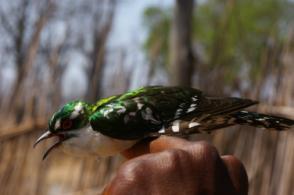
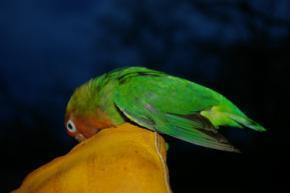
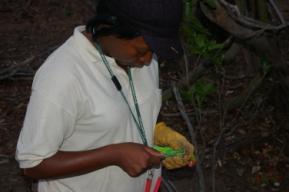
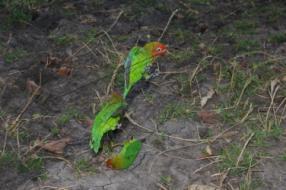
December 2011 – January 2012
Several planned field trips were cancelled due to the unavailability of fuel. Where ever possible I managed to get a lift from the tour operators and simply made observations of the lovebirds feeding and other interactions. Around Mid January we managed to get a permit to buy fuel in a jerry can thus organised another trip. Unfortunately all the mist netting attempts were unsuccessful during these visits. Plant samples for all plants that lovebirds were seen feeding on were collected and sent to the National herbarium for identification. A few have also been deposited at the herbarium at the Uiversity of Kwazulu Natal and seed samples will be sent for analysis in a lab in South Africa. We also received a donation of a spotting scope and some binoculars from the RSPB during this month.
February – March 2012
During this month we planned to monitor the agricultural fields and try to mount transmitters in the fields. Maize fields and Sorghum fields were visited from the first two weeks of the month. No lovebirds were observed feeding in the field. The sorghum plant on which they feed, is yet to reach maturity in most of the areas. Communities requested that we return in the early weeks of March. We managed to return to the field in the week beginning 5th March to 12th March but there lovebirds were still not feeding in peoples fields but rather in a large dambo area near Masange river. The next mist netting attempts will be carried out in this dambo area.
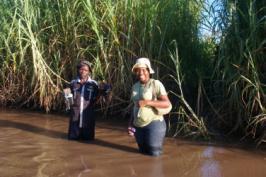
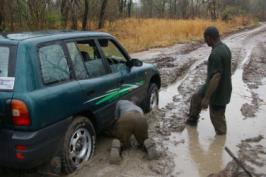
Getting in, out and around the park wasn’t easy in the rainy season!!!
Next Steps
For the next two months we will be putting more efforts in mist netting to ensure that the equipment was mounted on birds. Idea wild has donated more equipment thus a total of 10 will be mounted. Several identified volunteers will then be using the other equipment to radio-track and monitor movements for a total of 40 days. Another emphasis will be placed on observing breeding ecology. We sincerely thank all our supporters for making this possible!!!!!!!
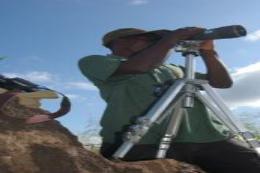
Lilians Lovebird Brief Report (Sept2012 – Aug2013)
This was a very busy period which involved four main activities, Transect walks, collection of food samples, bird ringing and monitoring breeding sights. This year we walked all the twenty four transect in the park with the help of the department of National Parks and Wildlife staff. We also collected all food samples that the lovebirds were seen feeding on and sent them for lab analysis. An area in the park was finally identified where it was a lot easier to mist net the lovebirds. We already had a few retraps during this area so it is very encouraging.
If the retrap rate of ringed birds remains high, we would suggest the use of some of the new satellite devices on the market for a smaller in the future. In November 2012 we also set up our first camera traps provided by the University of Kwazulu Natal which helped to monitor the breeding season. During this period I also presented my work at the 13th Pan African Ornithological Conference in Tanzania in October 2012 and the Zoological Society of Southern Africa in July 2013. I am now back at the university and preparing the some papers from the work that we have done.
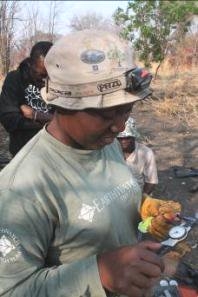
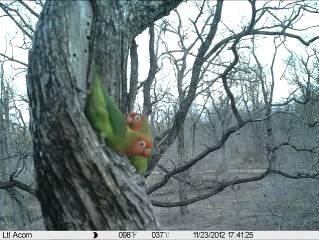
Figure 1: (above) Bird ringing in Liwonde and one of the photos the new camera’s are taking on lovebird roost.
We also sensitized schools around the national park. Students have been encouraged to report any lovebird sightings in their home villages. We have already received some very exciting reports of areas we had not visited. We were particularly interested in places where lovebirds were feeding in agricultural fields to understand whether they are a significant pest. The story on this work was featured on the birdlife website. Main data collection has now completed and we are busy analysing the data. Your Support as donors has been greatly appreciated.
By
TIM
________________________________________________________________________
Agapornis Research in the Caribbean
We are donating a large amount of bands, band cutters, scales, hand feeding pipettes, etc., to an ornithological organization which is lacking funds and need to acquire these items. If you would like to help by also donating some of the above items please write to us at AgapornisBE@gmail.com
SPANISH
Si usted quiere ayudar tambien en donar algunas cosas por favor escribanos a AgapornisBE@gmail.com
_________________________________________________________________________
If you donated, we would like to thank those who have donated graciously to the studies/research regarding the agapornis. Your gesture is appreciated as research is an important part of the survival of certain agapornis species in the wild. THANK YOU!
SPANISH – Si usted dono, queremos dar las gracias a esas personas quienes donaron a los estudios/investigaciones científicas de agapornis. Este gesto es apreciado ya que las investigaciones científicas con ciertas especie de agapornis son muy importante para que puedan sobrevivir en la naturaleza. ¡GRACIAS!
** COPYRIGHT AGAPORNIS BREEDERS & EXHIBITORS
Agapornis Breeders & Exhibitors




